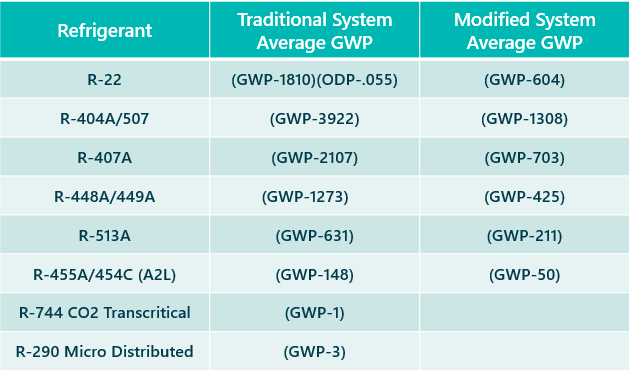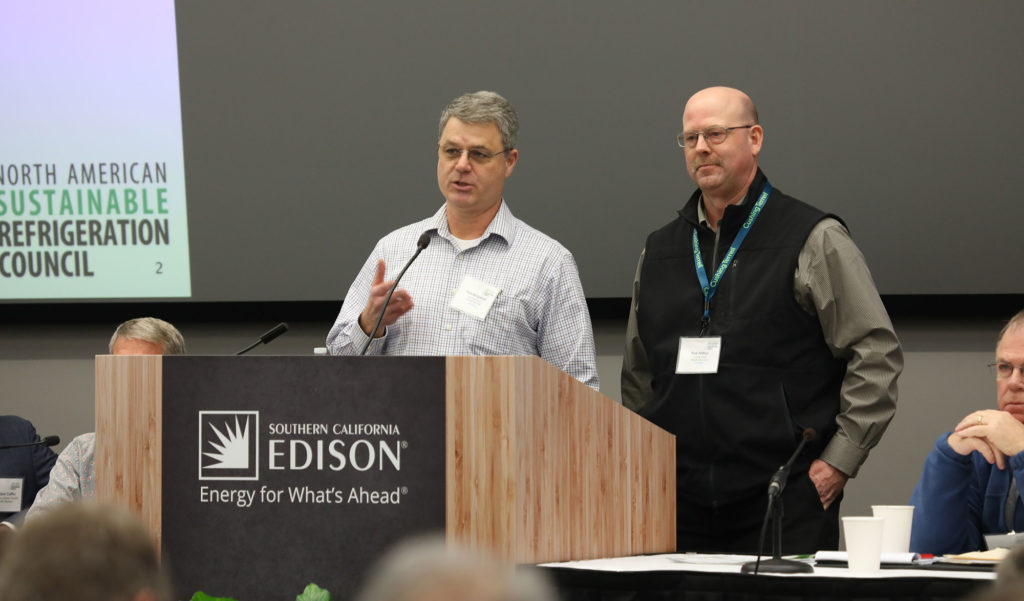Refrigerant Technologies: The Options and Why they Matter
According to the non-profit research organization Project Drawdown, refrigeration management is one of the top solutions to global warming. This significant impact is why the state of California is taking steps to drive big changes in the cooling and refrigeration sector.
For a recent session at the North American Sustainable Refrigeration Council’s (NASRC) Low-GWP & Energy Efficiency Expo, I teamed up with Tom Wolgamot from DC Engineering to talk specifically about the options for grocery retailers as they look to update their existing facilities and meet new regulations.
 Tom Wolgamot from DC Engineering and Rob Arthur with Cushing Terrell lead a “Shark Tank”-like presentation with panelists from major retailers. The NASRC event convened 180 attendees to discuss new regulations, emerging technologies, challenges, and solutions for the commercial refrigeration industry.
Tom Wolgamot from DC Engineering and Rob Arthur with Cushing Terrell lead a “Shark Tank”-like presentation with panelists from major retailers. The NASRC event convened 180 attendees to discuss new regulations, emerging technologies, challenges, and solutions for the commercial refrigeration industry.
The scenario
Hydrofluorocarbons (HFCs) are chemicals commonly used for cooling and refrigeration. They are the fastest growing greenhouse gases in the world and have a global warming potential 1,000-3,000 times that of CO2. In response, California plans to reduce HFC emissions by 40 percent below 2013 levels by 2030. The proposed legislation will ban HFCs above a global warming potential (GWP) of 150 for most large refrigeration equipment, and grocery retailers will have a big role to play. To accommodate varying situations and budgets, companies also need more than one path to compliance.
With stakeholder input gathered by the California Air Resources Board (CARB), it was determined that a GWP of less than 150 was feasible for new construction and remodels, but expensive and logistically challenging for existing facilities. Working in partnership with supermarket companies, CARB developed an alternative for existing systems: a weighted-average GWP reduction whereby there is a fixed target (less than 1,400 by 2030) by company, not per system. This will allow companies to make modifications where they make the most sense. For example, in stores with already planned remodels or upgrades.
The options
System conversion: With a basic system conversion, we change out the refrigerant to a lower GWP option while the mechanical systems remain intact. The initial step is conversion to 448A/449A refrigerant, bringing a traditional system down to an average GWP of 1273. This option has the lowest up-front cost and a minimal project duration of about three weeks.
System replacement: A full replacement to a CO2 transcritical system provides the greatest energy savings as the technology is well developed; however, this solution is on the high-end for cost. Projects tend to be four to six months in duration and can be phased. New fixtures and electronic controls can result in additional efficiency gains.
Modified system (reuse high side, replace or retrofit low side): For facilities with older fixtures in need of updating, a partial replacement or retrofit is an option where the existing “high side” is reused, while the “low side” is replaced or retrofitted to allow for the use of CO2. As codes develop, a future step is conversion of the high-side to an A2L refrigerant, bringing a modified system down to an average GWP of 50. For the retrofit option, the existing fixtures must be able to accommodate the higher pressures needed for CO2, or a new CO2 coil can be installed. The cost is about is about half that of a full system replacement with a project duration of three to five months.
Micro distributed: Micro-distributed systems located at cases and walk-ins replace large refrigeration systems that are connected to every case, cooler, or freezer. These smaller systems reduce the amount of piping and refrigerant needed, as well as minimize leak potential. Additionally, fixtures can be replaced as budgets allow and to align with merchandising needs. If the entire existing system is replaced, the cost associated with this option is similar to that of replacing the existing system with a CO2 transcritical system.

The incentives
Beyond the climate benefits from the phase out of HFCs and the adoption of advanced refrigeration technologies, commercial operations can see energy savings and apply for energy efficiency rebates with California utilities. CARB provides information on incentive programs on their website and NASRC continues to advocate for additional financing options.
How we can help
At Cushing Terrell, we are using our refrigeration engineering expertise to help clients meet the new regulations in California and other states as they move forward with similar legislation. We specialize in natural refrigerant options, and in delivering both traditional and advanced refrigeration systems, including three of the five NH3/CO2 cascade systems in the United States.
Get in touch with us to learn more about new regulations, what they may mean for your business, and what you can do now to help curb refrigeration-based greenhouse gas emissions.

Co-director of Cushing Terrell’s retail design team and principal-in-charge of refrigeration engineering, Rob Arthur is dedicated to putting forth cutting-edge solutions and systems that result in high-efficiency, low-emission retail and grocery spaces. He gathers together the best minds from our integrated, multi-disciplinary firm, along with visionary partners, to meet the needs and aspirations of our regional and national clients.

 Tom Wolgamot from DC Engineering and Rob Arthur with Cushing Terrell lead a “Shark Tank”-like presentation with panelists from major retailers. The NASRC event convened 180 attendees to discuss new regulations, emerging technologies, challenges, and solutions for the commercial refrigeration industry.
Tom Wolgamot from DC Engineering and Rob Arthur with Cushing Terrell lead a “Shark Tank”-like presentation with panelists from major retailers. The NASRC event convened 180 attendees to discuss new regulations, emerging technologies, challenges, and solutions for the commercial refrigeration industry. 
